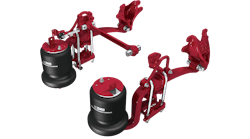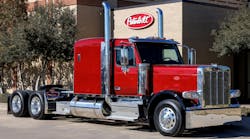A fiery crash near Detroit MI recently shows the need for greater automobile driver safety awareness and education advocated in the American Trucking Associations' 18-point safety agenda. The crash also revealed skills and safe practices common among professional truck drivers, said Clayton Boyce, ATA vice-president of public affairs. A tanker truck, a tractor-trailer, and a car were involved in the crash that set the tanker's load of fuel on fire, causing the collapse of an overpass over Interstate 75 north of Detroit. The crash happened during the evening of July 15.
“Police say evasive action by two alert truck drivers prevented further devastation after a car lost control on a Detroit-area highway and caused an accident that led to a fuel tanker explosion and overpass collapse,” the Toledo Blade said.
Michigan State Police said the driver of the car, a 27-year-old man, apparently lost control of his car while driving about 70 mph along a curve with a suggested speed of 50 mph. Police said the car swerved into the tanker, causing the cab and trailer to separate, the Detroit Free Press reported. The driver of the tanker truck might have been able to bring it to a stop without a devastating fire if the car's impact had not forced the tanker and cab apart.
The crash underscores the need for more automobile driver education, as suggested by the ATA's 18-point safety agenda. Independent studies show that 65% to 80% of serious truck-car crashes are caused by the passenger vehicle driver. According to the AAA Foundation for Traffic Safety, passenger vehicles cause about 75% of fatal car-truck crashes. Through analysis of on-road video footage, the Virginia Tech Transportation Institute found that passenger vehicles initiated 82% of crashes. Other studies estimated lower figures but also said car drivers caused more serious car-truck crashes than did truck drivers.
ATA endorses the Ticketing Aggressive Cars and Trucks (TACT) program, initiated by the Department of Transportation's Federal Motor Carrier Safety Administration. TACT is both an education and enforcement program that puts police officers into truck cabs to monitor both car and truck driver behavior on the highway, and drivers violating important traffic laws are ticketed. The ATA endorses greater enforcement of traffic and safety laws and regulations against truck drivers as well as auto drivers.
The trucking industry can also do more to improve highway safety. ATA's 18-point plan will improve highway safety for auto drivers and passengers by addressing three areas: improving driver performance, choosing safer vehicles, and improving motor carrier performance. ATA is pursuing this safety agenda even though US DOT statistics show that the US trucking industry is the safest it has ever been.
The 18 safety policies on ATA's agenda are:
Improving Driver Performance:
-
Consider restrictions on the use of non-integrated technologies while the vehicle is in motion
-
Uniform commercial driver license (CDL) testing standards
-
CDL graduated licensing study
-
Additional parking facilities for trucks
-
National maximum 65-mph speed limit for all vehicles
-
Strategies to increase use of seat belts
-
National car-truck driver behavior improvement program
-
Increasing red light cameras and automated speed enforcement
-
Graduated licensing standards for non-commercial teen drivers
-
More stringent laws to reduce drinking and driving
Safer Vehicles:
-
Targeted electronic speed governing of certain non-commercial vehicles
-
Electronic speed governing of all large trucks manufactured since 1992
-
Better large-truck crashworthiness standards
Safer Motor Carriers:
-
National employer notification system
-
National clearinghouse for positive drug and alcohol test results of CDL holders
-
National registry of certified medical examiners
-
Access to the national Driver Information Resource
-
Required safety training by new-entrant motor carriers








